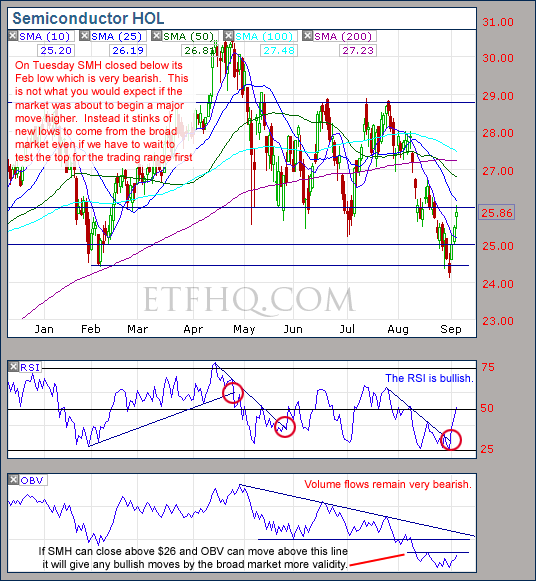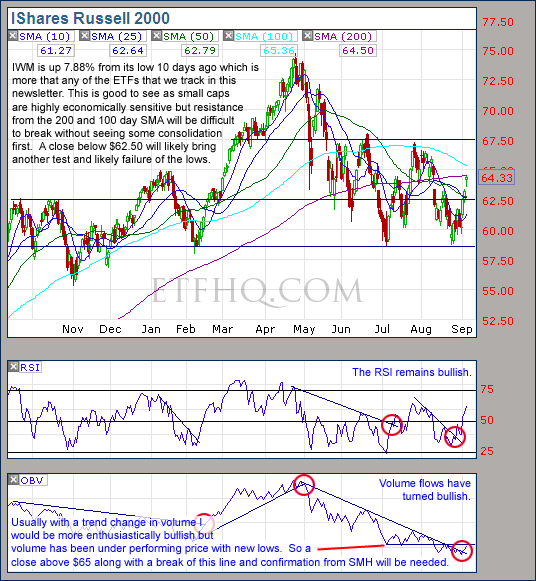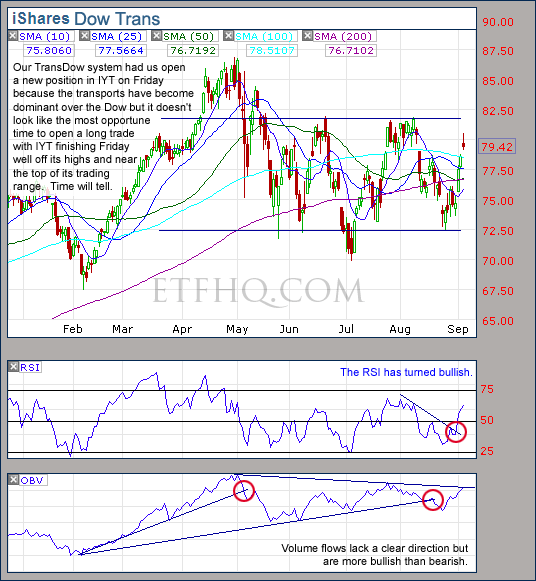September 07, 2010 – 07:00 am EDT
What a week, and what a way to kick off September. Now a quick rant for those if you who say that September is a bad month for stocks… You are completely missing the point! It is very dangerous to base trading decisions on a calendar pattern becuase there is no law that states one month with be better than another.
Where there is no law there is nothing to measure, so any pattern is most likely due to coincidence or has simply become a self-fulfilling prophecy. Such patterns can disappear without warning. If there is a genuine reason behind a calender pattern such as fund flows due to tax time etc. then design your system to measure that reason… not the calendar! End rant.
In our last newsletter we warned that there were several bullish signs and to expect short term strength. Well over the last week we have certainly seen strength and far more than expected. All the levels set as targets were reached and convincingly exceeded. The speed of the advance was probably fueled by short covering but was so impressive that it brings into question my theory that we are headed for new lows. So lets take a closer look…
****Thanks to all those who referred people to this newsletter over the last week. The more readers we have the more services we can provide you.
.
ETF % Change Comparison
.

This week I have added a measure of how far each of the influential ETFs are from their recent lows. Leading the advance was IWM and IYT who were also the first to bounce off their lows 10 days ago. This is impressive as the small caps and the transports are highly economically sensitive. On a not so impressive note; SMH and QQQQ are only 3 days off their lows. In a strong market it would be rare for them to getting left behind like this. These conflicting internals help to explain why the market remains stuck in a range.
Learn more – ETF % Change Comparison
.
![]()
.
A Look at the Charts
.

SPY exceeded expectations to the upside but volume flows remain bearish and the 100 day SMA stands as resistance.
.

QQQQ remains one of the strongest bullish arguments; volume is healthy and OBV never made a new low like it did on SPY, SMH and IWM. The 100 day SMA stands as resistance and a close below $45 will put us back on track for new lows.
.

SMH provides the strongest bearish argument; very negative volume flows and a close on Tuesday below its Feb low. This action highlights internal cracks in this market that should not be ignored.
.

A trend change from volume, strong support and market leadership; this is very bullish. With a close above $65 and a bit more volume this move will be believable.
.

IYT had a poor finish on Friday despite a very strong week. Looks desperate for some consolidation.
.
![]()
.
OM3 Weekly Indicator
.

The only ETF still on a sell signal is SMH while everything else has switched to strong buy. It would be much better to see SMH being the first to gain a buy signal rather than the last. The bull alerts indicate that the weekly cycle has begun to turn up.
Learn more – The OM3 Indicator
.
![]()
TransDow & NasDow
.

The TransDow system indicates that the Transports have become dominant over the Dow which is a bullish sign and a new position was opened in IYT on Friday. The NasDow remains on ‘No Signal’ indicating that there is no clearly dominant index between the Dow and the NASDAQ.
.
What the TransDow Readings tell us:
The TransDow measures dominance between the DJ Transportation Index (DJTI) and the Dow Jones Industrial Average (DJIA). In a strong market the more economically sensitive Transportation Index should be dominant over the DJIA.
Historically the DJTI has been dominant over the Dow 45% of the time. The annualized rate of return from the DJTI during this period was 18.47% with the biggest loss for one trade sitting at -13.27%. The annualized return from the DJIA during the periods it was dominant over the DJTI was just 4.06% and the biggest loss for one trade was -16.13%. A 4% stop-loss is applied to all trades adjusting positions only at the end of the week.
What the NasDow Readings tell us:
The NasDow measures dominance between the NASDAQ and the DJIA. Using the same theory behind the Trans Dow; in a strong market the more economically sensitive NASDAQ should be dominant over the DJIA.
Historically the NASDAQ has been dominant over the DJIA 44% of the time. Taking only the trades when the NASDAQ is above its 40 week moving average the annualized rate of return was 25.47% with the biggest loss for one trade sitting at –8.59%. The annualized rate on the DJIA during the periods it was dominant over the NASDAQ is just 8.88% and the biggest loss for one trade was –12.28%. A 8% stop-loss is applied to all trades adjusting positions only at the end of the week.
.
![]()
.
LTMF 80 & Liquid Q
.

Both LTMF 80 and Liquid Q remain in cash.
.
Historical Stats:
.

.
How The LTMF 80 Works
LTMF stands for Long Term Market Forecaster. It reads volume flows relative to price action and looks for out performance of volume measured on a percentage basis over the prior 12 months. During a sustained rally the readings will reach high levels (near 100%) making it imposable for the volume reading to always outperform price so any reading above 80% will maintain the buy signal. This system has outperformed the market over the last 10 years but performance has been damaged by some nasty losses. It only produces buy signals and only for QQQQ.
How Liquid Q Works
Liquid Q completely ignores price action and instead measures the relative flow of money between a selection of economically sensitive and comparatively stable ares of the market. It looks for times when the smart money is confident and and can be seen by through volume investing heavily is more risky areas due to an expectation of expansion. This system has outperformed the market over the last 10 years and remained in cash through most of the major declines. It only produces buy signals and only for QQQQ. We will provide more performance details on the web site for these systems soon.
.
![]()
.
Summary
The advances over the last week were certainly impressive but the speed of advance is totally unsustainable. Now many of the Indices are simultaneously against resistance so consolidation is likely to be the best outcome for now. If SMH can close above $26, IWM above $65 and QQQQ above its 200 day SMA then a solid attempt at new highs will be on the cards. On the other hand if QQQQ closes below $45 and IWM below $62.50 then I will expect a test and likely failure of the lows.
On a side note here is a fantastic – Visual Guide To Inflation – Enjoy.
.
Any disputes, questions, queries, comments or theories are most welcome in the comments section below.
.
Cheers
Derry
And the Team @ ETF HQ
“Equipping you to win on Wall St so that you can reach your financial goals.”
.
P.S Like ETFHQ on Facebook – HERE
.
![]()
.
Quote of the Day:
“If you have trouble imaging a 20% loss in the stock market, you shouldn’t be in stocks.” – John (Jack) Bogle
Derry,
If you draw down trend lines from the April and June highs, you will notice that many of the important ETF’s closed right at that down trend line on Friday. My opinion is that we are going to get a reversal today (Turn around Tuesday) that will take those ETF’s to new lows in the near future.
Mike Scott
That is a great observation Mike. Thanks for your thoughts.
Derry
There is a typo in the “Summary”. I think it should be $62.50 instead of “IWM below $65.50”
Thanks very much for pointing that out. I will fix it now.
Cheers
Derry
Thanks very much for pointing that out. I will fix it now.
Cheers
Derry
Thanks very much for pointing that out. I will fix it now.
Cheers
Derry
Thanks very much for pointing that out. I will fix it now.
Cheers
Derry
Thanks very much for pointing that out. I will fix it now.
Cheers
Derry